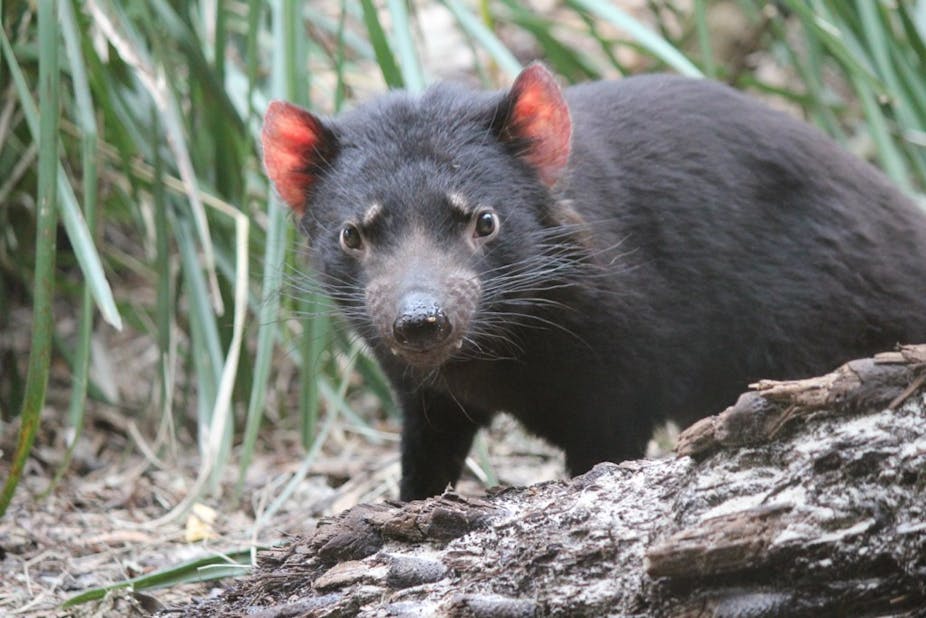Recently there have been discussions around reintroducing Tasmanian devils to parts of the Australian mainland. Some have even predicted that devils could help conserve biodiversity by controlling the feral cats and foxes that currently prey on a range of threatened species.
Some of these predicted benefits are said to be based on “evidence from Tasmania”. But how much evidence do we really have?
As part of a study investigating the cause of decline of the eastern quoll, we and our colleagues investigated interactions between devils, feral cats and quolls in Tasmania. Our findings published today in PLOS ONE suggest that there’s no easy answer to the devil and cat conundrum.

What’s the link between cats and devils?
In Tasmania, it has been suggested that devils may control feral cats through competition and possibly predation. With devil populations currently being decimated by the spread of the fatal Devil Facial Tumour Disease (DFTD), it was predicted that devil declines would allow feral cat numbers to increase, threatening a range of small and medium-sized prey species.
In north east Tasmania (where DFTD was first detected in 1996 and devils have been in decline the longest), government spotlight surveys detected an increase in cat sightings following devil decline.
This increase in cat sightings has often been interpreted as an increase in cat numbers, with suggestions that eastern quoll declines may then be linked to an increase in cats. While this interpretation might fit with predictions, our findings suggest that such conclusions may be premature.
Contrary to predictions, we found no support for the hypothesis that devils control cat numbers. Sites with more devils did not have fewer cats, and conversely, sites with fewer devils did not have more cats.
Further, we did not find higher cat numbers in north east Tasmania where devils had declined for 13-16 years.
So how do we explain the increase in cat sightings?
Scaredy cats
Devils might not control the number of cats – but they may affect their behaviour.
The key for predators to co-exist is avoidance. By concentrating activity into times and places where large predators are less active, smaller predators such as cats reduce the risk of aggressive encounters with larger predators such as devils.
In our study, we found that cats and devils used the same areas, with cats observed at 92% of sites where devils were detected. While cats appeared to avoid individual cameras where devils were detected (a finding consistent with other studies), they were usually detected on cameras located only a few hundred metres away at the same site. This suggests that cats may avoid areas where devils are active, but only over short distances.
We also found evidence that cats and devils were active at different times. Cats were more active during the day, but in north east Tasmania where devils have been in decline the longest, cats were more active at night.
This suggests that cats may have previously hunted during the day to avoid nocturnally active devils. But with fewer devils to encounter following DFTD, it may now be safer for cats to shift their activity and hunt at night.
Even without an increase in cat numbers, this apparent shift in cat activity presents an emerging threat to a range of nocturnal prey species that may have rarely seen cats prior to DFTD.
If cats are now more active at night following devil decline, the increase in cat sightings in north east Tasmania may simply reflect a shift in cat activity times, with nocturnal cats now more detectable in spotlight surveys conducted at night.

Are cats to blame for quoll declines?
Eastern quolls have declined by more than 50% over the 10 years to 2009 with no sign of recovery. Our research investigated whether this decline might have been linked with changes in cat populations following devil declines.
Contrary to predictions, we found no evidence that cats contributed to the recent quoll decline. But our findings suggest that cats might be preventing populations from recovering by killing young quolls.

At a stable quoll site on Bruny Island, the number of quolls trapped predictably increased over summer as new young quolls emerged - an annual cycle that has been observed historically in stable quoll populations.
However, at our three study sites where quolls had declined, this summer population spike did not occur, suggesting that juveniles are not surviving to enter the population, possibly because cats are eating them.
We found that cat activity changed seasonally, with daytime activity in winter but more nocturnal activity in summer – the time of year when vulnerable juvenile quolls first emerge from their dens.
Unfortunately, this predation intensity may increase further should cats become more nocturnal following devil decline.
The outlook
We have only just begun to understand how devils, cats and quolls interact in Tasmania. Extensive research is currently underway that will hopefully provide us with some much needed insights over coming years.
We provide a cautionary tale that highlights the need to consider alternative hypotheses to explain observed patterns, as the implications for species conservation could vary dramatically.
Bold decisions and novel approaches are required to stem the rising tide of Australian mammal extinctions. Proposals to reintroduce devils to the mainland are commendable and may potentially yield benefits for species conservation.
However, our findings from Tasmania suggest that the predicted benefits of such reintroductions may not be so predictable.

